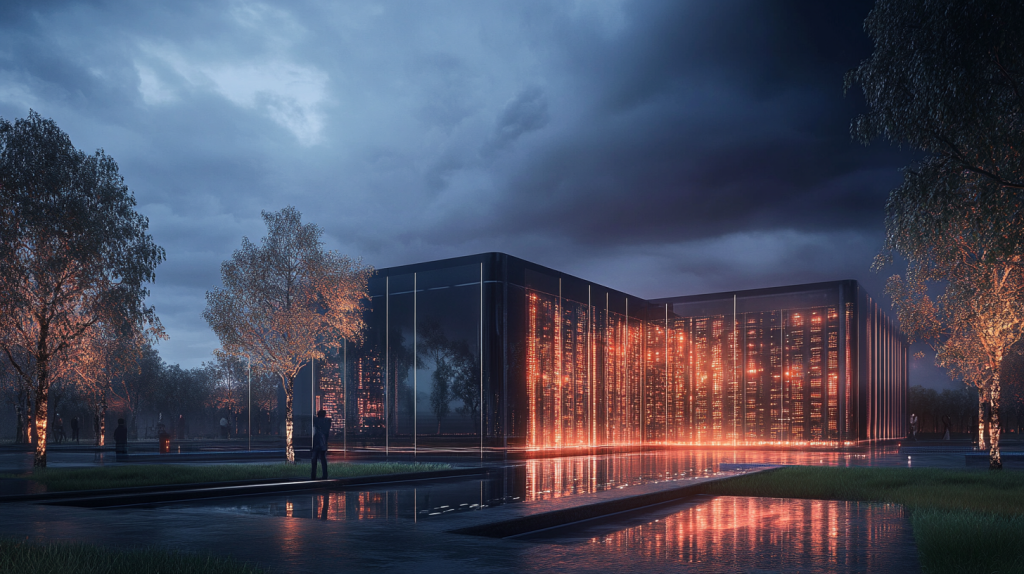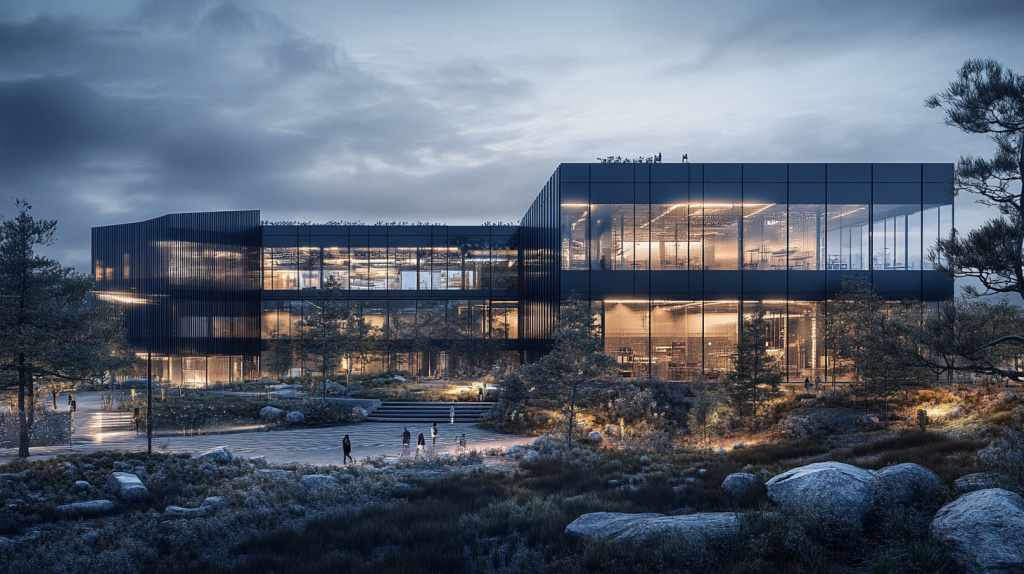Hyperscale Data Center Construction: How to Simplify Multi-Tier Scheduling for Hyperscale Data Center Construction
Table of Contents:

Building a hyperscale data center isn’t just another construction project—it’s a high-stakes, high-speed, high-complexity operation where every minute counts. With massive footprints, thousands of interconnected systems, and multiple contractors working in parallel, coordinating schedules across multiple tiers of construction is like choreographing a high-tech ballet with cranes, electricians, and HVAC technicians.
Multi-tier scheduling ensures that each phase of the construction process—from foundation work to electrical installations to server rack deployment—is perfectly aligned to keep everything on track. But if just one team falls behind, it can create a domino effect, throwing off the entire timeline. That’s why simplifying multi-tier scheduling with smarter coordination, AI-driven planning tools, and real-time workforce management is key to keeping hyperscale data centers on schedule and within budget.
This guide will explore the best scheduling strategies for hyperscale data center construction, helping project managers streamline workflows, improve labor efficiency, and minimize costly delays.
Understanding Multi-Tier Scheduling in Hyperscale Data Center Construction
Multi-tier scheduling breaks down a hyperscale data center build into sequential, overlapping, and interdependent work phases. These tiers include site preparation, structural construction, mechanical/electrical/plumbing (MEP) installation, IT infrastructure deployment, and commissioning. Each stage must be precisely coordinated so that materials, labor, and installation teams arrive at the right place at the right time.
Unlike smaller construction projects, hyperscale builds require parallel workflows. For example, while electrical teams are installing power infrastructure in one section, IT teams may be deploying networking hardware in another. If workflows aren’t aligned, congestion, labor inefficiencies, and missed deadlines become inevitable.
By leveraging multi-tier scheduling strategies, teams can ensure that each phase flows into the next without bottlenecks. Real-time scheduling tools, such as StruxHub Scheduling, help project managers dynamically adjust labor allocations based on actual site conditions and progress tracking.
Key Benefits
- Ensures seamless workflow transitions between project phases.
- Reduces schedule conflicts and workforce inefficiencies.
- Improves resource planning for equipment, labor, and materials.
Best Practices
- Develop a tiered project roadmap that sequences every phase of construction.
- Implement real-time workforce tracking to prevent scheduling conflicts.
- Use predictive scheduling tools to adjust project timelines dynamically.
By simplifying multi-tier scheduling, hyperscale data center projects can maintain high efficiency, minimize labor waste, and keep complex construction workflows running smoothly.

Coordinating Workforce Scheduling Across Multiple Tiers
With hundreds of workers from multiple trades on-site at the same time, hyperscale data center projects require meticulous workforce scheduling. If trade crews aren’t scheduled efficiently, construction zones can become overcrowded, unsafe, and inefficient, leading to delays, miscommunication, and higher labor costs.
One of the biggest challenges is avoiding overlap between dependent tasks. For example, if HVAC installers arrive before the ductwork is completed, their progress is stalled. Similarly, electrical teams can’t begin work on switchgear installations if power distribution panels haven’t arrived.
To solve this, project managers should layer workforce scheduling based on construction priorities. Scheduling platforms like StruxHub Scheduling allow teams to coordinate across multiple tiers, ensuring that each crew arrives only when their assigned task is ready for execution.
Key Benefits
- Optimizes trade-specific scheduling to prevent congestion.
- Enhances communication between general contractors, suppliers, and labor teams.
- Reduces overtime and unnecessary labor costs.
Best Practices
- Use automated scheduling systems to adjust workforce shifts based on project progress.
- Schedule trade teams in sequence to avoid job site overcrowding.
- Monitor workforce productivity in real-time to identify scheduling inefficiencies.
By aligning workforce schedules with tiered project phases, hyperscale data centers can avoid labor bottlenecks, improve efficiency, and keep the entire build on schedule.
Related Articles:

Just-in-Time Material Delivery for Hyperscale Projects
Hyperscale data centers require millions of components, from structural materials to backup generators, cooling systems, and IT racks. If materials arrive too early, they take up valuable storage space. If they arrive too late, labor teams are left waiting, delaying installations.
The just-in-time (JIT) delivery model ensures that materials arrive only when needed, optimizing storage and reducing handling risks. However, coordinating JIT deliveries across multiple project tiers requires real-time tracking and predictive scheduling. Platforms like StruxHub Deliveries help teams track shipments, monitor supplier performance, and adjust workforce schedules dynamically.
Key Benefits
- Minimizes storage congestion by limiting excess materials on-site.
- Ensures critical materials arrive precisely when needed.
- Reduces waste, material damage, and handling costs.
Best Practices
- Integrate real-time delivery tracking with scheduling systems.
- Monitor vendor reliability and adjust procurement schedules proactively.
- Schedule critical equipment deliveries based on project phase priorities.
JIT delivery strategies improve construction efficiency, prevent costly material delays, and keep hyperscale data centers on track for completion.
Reducing Scheduling Conflicts with AI-Powered Coordination
When hundreds of workers are spread across multiple job sites, scheduling conflicts are inevitable—unless you’re leveraging AI-powered scheduling tools to keep everything running smoothly. In hyperscale data center construction, where mechanical, electrical, plumbing (MEP), IT infrastructure, and security teams all work in parallel, a single scheduling misalignment can delay an entire phase of the project.
Traditional scheduling methods rely on manual tracking, spreadsheets, and static timelines, which are vulnerable to last-minute changes. AI-driven scheduling software, however, analyzes workforce availability, material deliveries, and project dependencies in real time, automatically adjusting schedules when conflicts arise. If a delivery is delayed or a work crew is behind schedule, AI can instantly reschedule tasks, reallocate resources, and notify affected teams to prevent costly downtime.
Platforms like StruxHub Scheduling allow teams to integrate AI-powered coordination, ensuring that critical tasks are adjusted dynamically based on job site conditions. By using predictive analytics, project managers can identify potential bottlenecks before they occur and adjust schedules proactively.
Key Benefits
- Reduces project downtime caused by scheduling conflicts.
- Improves real-time communication between contractors and suppliers.
- Ensures optimized labor allocation based on changing site conditions.
Best Practices
- Use AI-based workforce coordination tools to automate scheduling updates.
- Implement real-time tracking of labor productivity and material availability.
- Schedule weekly planning meetings to ensure cross-trade alignment.
AI-powered scheduling eliminates conflicts, reduces inefficiencies, and ensures that every phase of the project stays on track, making it a must-have for hyperscale data center construction.

Synchronizing IT Infrastructure Deployment with Construction Schedules
A hyperscale data center isn’t just a giant building full of racks—it’s an intricate system of IT networking, power distribution, and security protocols that must be deployed in sync with construction progress. If IT infrastructure arrives before the power systems are installed, it’s useless. If networking teams start before the cooling infrastructure is online, overheating becomes a problem.
The key to avoiding these issues is synchronizing IT deployment with construction schedules, ensuring that networking, cabling, and rack installations happen only when supporting infrastructure is in place. By using tiered scheduling, project managers can sequence IT deployments in parallel with electrical and mechanical installations, minimizing downtime and ensuring that every system is ready when needed.
Key Benefits
- Reduces equipment downtime caused by premature installations.
- Ensures networking and IT teams work efficiently without waiting for supporting infrastructure.
- Improves communication between construction and IT deployment teams.
Best Practices
- Use tiered scheduling strategies to sequence IT deployment with infrastructure readiness.
- Integrate real-time communication tools for IT and construction teams.
- Conduct pre-installation site assessments to verify power and cooling readiness.
By aligning IT infrastructure deployment with construction milestones, hyperscale data center teams can avoid costly delays, optimize installation efficiency, and ensure seamless network integration.
Managing Shift-Based Scheduling for Continuous Workflows
In hyperscale data center projects, there’s no such thing as downtime. With tight deadlines and 24/7 project cycles, continuous workflow scheduling is critical for keeping construction on track. However, poorly planned shift-based scheduling can lead to worker fatigue, increased labor costs, and inefficient workflows.
A well-executed shift-based schedule ensures that work crews rotate efficiently, minimizing worker burnout while maintaining 24/7 productivity. Staggered shifts allow day teams to focus on infrastructure installations, while night crews handle testing, inspections, and finishing work without interfering with heavy construction activities.
To manage shift-based scheduling effectively, project managers should use real-time workforce tracking tools that provide visibility into worker availability, shift overlaps, and productivity metrics. Platforms like StruxHub Scheduling help optimize shift transitions, ensuring that teams are deployed efficiently without unnecessary overlap or labor gaps.
Key Benefits
- Maintains 24/7 construction progress without worker fatigue.
- Reduces overtime costs by optimizing labor distribution.
- Prevents worksite congestion by scheduling shifts based on project needs.
Best Practices
- Implement rotating shift schedules to prevent worker exhaustion.
- Use real-time workforce tracking tools to monitor productivity.
- Schedule off-peak construction activities for night shifts to optimize workflow.
Shift-based scheduling ensures continuous progress in hyperscale data center construction, balancing productivity and worker well-being while keeping project timelines intact.
Optimizing Commissioning Schedules for Faster Project Turnover
The commissioning phase is the final frontier before a hyperscale data center goes live, but if commissioning schedules aren’t aligned with construction milestones, it can lead to unexpected delays, compliance issues, and last-minute fixes.
Optimizing commissioning schedules requires a proactive approach, ensuring that all electrical, cooling, and IT systems are tested and validated as soon as they’re installed rather than waiting until the end of the project.
By using integrated commissioning plans, teams can start functional testing in parallel with construction, allowing for progressive system handovers instead of an all-at-once bottleneck. This accelerates the project turnover timeline and ensures that any issues are resolved early, reducing the risk of delays before go-live dates.
Key Benefits
- Reduces last-minute testing delays that can push back operational launch dates.
- Ensures compliance with safety and performance standards.
- Speeds up client handover and project completion.
Best Practices
- Implement progressive commissioning plans instead of last-minute testing.
- Use cloud-based commissioning tracking tools to monitor system readiness.
- Coordinate with vendors and facility teams to align testing schedules.
A well-optimized commissioning schedule ensures faster project turnover, helping hyperscale data centers go live on time with fully validated systems.

StruxHub: Revolutionizing Project Management in Large Commercial Construction
Unlock the Full Potential of Your Construction Projects with StruxHub
StruxHub enhances efficiency and coordination across all project phases, providing a single source of truth that eliminates silos and fosters collaboration. Real-time updates, financial management tools, and seamless commvunication features ensure that all team members and stakeholders are aligned and informed, reducing the risk of errors and delays. With comprehensive solutions for document management, risk mitigation, and quality control, StruxHub maintains project integrity and safety, while mobile access and integration capabilities further enhance project flexibility and efficiency.
StruxHub’s Key Features and Benefits:
- Advanced Delivery Management: Automate and optimize your delivery schedules, ensuring materials arrive just in time, every time.
- Site Communication: Utilize georeferenced maps and instant messaging to keep every team member informed and aligned.
- Construction Materials Management: Track inventory levels and manage materials procurement with ease, reducing waste and avoiding project delays.
- Construction Safety & Inspection Workflows: Implement customizable mobile forms for conducting safety inspections and managing compliance documentation effortlessly.
- Short-Term Scheduling: Visualize project tasks with detailed floor plans, linking each activity to specific locations for better planning accuracy.
- Construction Resource Management: Efficiently allocate personnel and equipment, maximizing productivity and reducing idle time.
StruxHub’s Product Offering:
- StruxHub Deliveries: Simplifies the coordination of incoming deliveries, ensuring materials and equipment are precisely timed to project needs.
- StruxHub Logistics: Offers intelligent site logistics planning, from crane scheduling to space allocation, for smoother operations.
- StruxHub Safety: Elevates on-site safety standards with easy-to-use tools for inspections, permits, and incident reporting.
- StruxHub Scheduling: Enhances project timelines with intuitive scheduling tools that ensure tasks are completed efficiently and on time.
With StruxHub, construction companies can look forward to a streamlined, more efficient project execution that delivers on time and within budget. Embrace the power of innovation and take your construction projects to the next level.
Don’t miss out on the opportunity to optimize your construction management processes with StruxHub. Sign up for a free demo today. Let’s build smarter, together.

FAQ
Why is multi-tier scheduling essential for hyperscale data center construction?
Multi-tier scheduling is critical for hyperscale data center construction because it allows teams to manage complex overlapping workflows, ensuring that each phase of construction—site prep, electrical installation, IT deployment, and commissioning—flows smoothly without bottlenecks.
By implementing a tiered scheduling framework, teams can coordinate workforce deployment, material deliveries, and installation phases more effectively, ensuring optimal productivity and minimal downtime.
How do AI-powered scheduling tools improve hyperscale project coordination?
AI-powered scheduling tools analyze workforce availability, delivery timelines, and construction progress in real time, automatically adjusting schedules to prevent conflicts and delays. These tools help project managers predict bottlenecks before they occur, ensuring that critical tasks are adjusted dynamically based on site conditions.
What challenges arise in workforce scheduling for hyperscale construction?
Common challenges include overlapping trade schedules, last-minute delivery delays, and labor shortages. If workforce scheduling isn’t aligned with construction progress, crews may arrive before materials are available, leading to wasted labor hours and unnecessary costs.
How does just-in-time material delivery benefit data center builds?
Just-in-time (JIT) delivery ensures that materials arrive only when needed, reducing storage congestion, handling risks, and material loss. By using real-time tracking platforms, teams can prevent supply chain disruptions and ensure that components are available at the right moment for installation.
What best practices help synchronize IT deployment with construction timelines?
To synchronize IT deployment, teams should implement phased scheduling, ensuring that networking infrastructure arrives only when power and cooling systems are operational. By using tiered scheduling strategies, construction and IT teams can work in parallel without interfering with each other’s progress.



